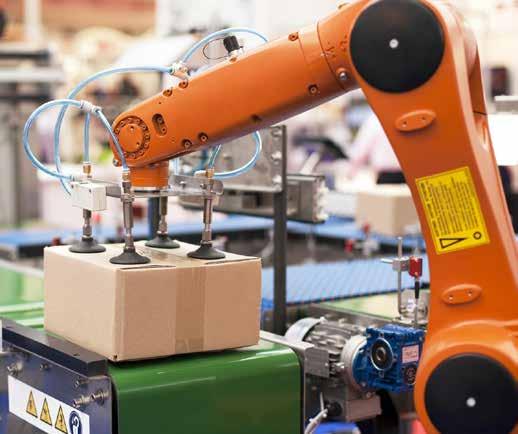
3 minute read
Advancing digital transformation Digital Digest
from SPN April 2023
by spnews.com
SPN is pleased to publish extracts from an recent paper posted in January this year by Emily Newton, a journalist who is no stranger to our SPN shores!
Why is Digitalisation Increasingly Important for the Packaging Industry? Packaging industry technology has become more advanced over the years. Such progress is necessary for helping established brands and industry professionals stay competitive and meet changing needs. Pursuing a digital transformation can also set some companies apart from others, assisting digital-first businesses to remain profitable. With so many enterprises ramping up digitalisation efforts, some people argue the packaging industry must follow suit to stay caught up.
Advertisement
Reducing Employee Injury Rates With Robots

Working as a packaging line employee can be physically strenuous due to the repetitive motions required. Decisionmakers at Orora Fresh Packaging Solutions invested in a robotic cell for its Canadian headquarters. The machine fed corrugated cardboard sheets into equipment that formed boxes from the material.
This change cut injury rates while reducing the number of employees needed to run the machinery. Employees could only put 10-15 cardboard sheets into the machine at once before the company invested in automation. This limitation meant they had to repeat the associated movements throughout the workday, increasing the chances of strain. The situation was even worse, considering it sometimes became very hot in the plant. These challenges often made it difficult to retain additional staff to accommodate seasonal peaks.
The company’s human resources manager also indicated some of its older packaging machines were particularly problematic in causing injuries when people reached up to load them. Since implementing the robotic solution, the company has achieved a seven-person decrease in the number of individuals needed to run its five box machines. However, it did this without eliminating any full-time positions at the plant. The automated elements of the technology updates also reduce the amount of scrap material produced while slashing the risk of trip and fall incidents. This example shows how packaging industry technology can have far-reaching effects.
Elsewhere, Amazon has a robotic work cell called Cardinal that uses computer vision and artificial intelligence to select, lift and transfer individual packages so they get to the right areas of the facility for further processing. It is testing a Cardinal prototype that can lift up to 50 lb. The company hopes to deploy it in fulfilment centres soon.
Enabling More Customised Options
Today’s business representatives increasingly recognize the worth of custom packaging. That might mean having boxes designed to welcome newly hired employees, complete with a company’s logo and colours. A university might appeal to parents who are missing their college-aged kids by selling custom care packages with a recipient’s name, a personalized message and the image of the institution’s mascot.
Digital transformation supports those offerings by streamlining and automating the necessary package modifications. Colgate-Palmolive recently ran a trial where people could get customised toothpaste after taking an online quiz. The questions aimed to learn people’s goals, whether they wanted whiter smiles, fresher breath or had something else in mind. Besides choosing the toothpaste’s colour and flavour, people could also customize how the package looked. The relevant packaging industry technology delivered products to buyers in as few as five business days.

Custom packaging also boosts brand recognition among customers. Imagine if a person arrives home after a busy day to find a beautifully branded package waiting on their doorstep. That experience can make the recipient feel instantly excited about enjoying what’s inside. The design may also include social media information that encourages people to share pictures and opinions of their purchases. Another benefit of customized packaging is an eye-catching design could encourage people to reuse the container. Personal care brand Rituals uses custom packaging with nature designs and inspiring quotes. It also includes easy-open features to reduce frustration and promote joy during the unboxing experience.
The increase in digitisation means people could create customized packaging by simply indicating a few preferences within packaging software or an online interface. That ease of production tends to shorten turnaround times, making nongeneric packaging more easily fit into a company’s workflow without causing delays.
Digital technology used in the packaging sector is also instrumental in reducing machine outages that could otherwise be prohibitively disruptive. That often happens with Industrial Internet of Things (IIoT) sensors that collect machine health data. The goal is to provide operators with valuable data about potential problems before those issues cause outages.
Moving Forward With Digital Transformation
The examples here show how digital upgrades can significantly improve packaging companies’ operations and expand their offerings to existing or potential customers. However, the best way to integrate packaging industry technology into workflows depends on a business’ current pain points and goals.
Leaders must also clarify how much they’ll spend on such improvements and what they’ll do to track progress. Examining a packaging facility’s layout is also necessary if the digitalization strategy involves investing in new machinery. Figuring out where to put the equipment before purchasing it emphasizes safety and productivity.
Clarifying the answers to questions like these will help executives make the most-informed decisions about when, why, and how to invest in packaging technology. Only then will they have the best chances of getting satisfying and profitable returns on investment.










